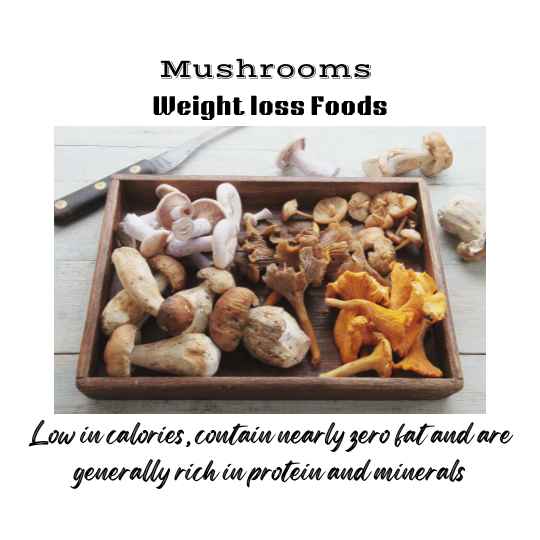Mushrooms are popular weight-loss food. They are of four kinds – saprotrophic, mycorrhizal, parasitic, and endophytic. Botanically, the mushroom is a fungus’s fleshy, spore-bearing fruiting body. There are said to be over 10000 varieties of mushrooms already identified. A saprophytic fungus feeds on decaying organic matter like deadwood etc. Some examples of edible saprophytic mushrooms include morel, shiitake, reishi, white button, cremini, oyster, maitake, etc.
Mycorrhizal mushrooms have the mycelia of these fungi either penetrate root cells or wrap around roots exchanging moisture and nutrition from these plants’ roots. It is a mutually beneficial relationship between the mushroom and the plant. Some edible mushrooms are truffles, porcini, chanterelles, etc.
Parasitic mushrooms thrive and draw sustenance from the plant on which they grow. It is a one-way relationship in which the host provides nutrition and nourishment to the mushroom. There are a few edible mushrooms in this category.
Endophytic fungi invade host tissue, but unlike parasitic fungi, the host remains healthy and appears to benefit from these fungi. Perhaps these fungi help increase nutrient absorption and build resistance to pathogens.
The world’s mushroom and truffle production estimate for 2011 was 8.5 million tons. China was the predominant producer with 5,008,850 tons, followed by Italy- with 761,858 tons, the US with -390,902 tons, and the Netherlands with 304,000 tons. (https://www.worldatlas.com/articles/the-world-s-top-producers-of-mushroom-and-truffle.html)
As a popular weight-loss food, mushrooms are low in calories, contain nearly zero fat, and are generally rich in protein and minerals. They provide minerals, trace elements such as potassium and copper, and vitamins such as riboflavin, niacin, and folates. Mushrooms are widely used in Chinese medicine. (Cheung, 2010) There is a wide variation in the nutritional properties of mushrooms.
Shiitake has the highest macronutrients, sugars, tocopherols, polyunsaturated fatty acids (PUFA), and the lowest saturated fats.
White and brown mushrooms have similar macronutrient compositions Oyster and king oyster mushrooms contain the highest monounsaturated fatty acids (MUFA) and similar other nutrients. Chemical compositions vary between cultivated and wild samples. (Reis et al., 2012)
Mushrooms are an excellent food for weight loss. They are low in calories, contain nearly zero fat, and are generally rich in protein and minerals. They provide minerals, trace elements such as potassium and copper, and vitamins such as riboflavin, niacin, and folates. Mushrooms are widely used in Chinese medicine. (Cheung, 2010) There is a wide variation in the nutritional properties of mushrooms.
Shiitake has the highest macronutrients, sugars, tocopherols, polyunsaturated fatty acids (PUFA), and saturated fats.
White and brown mushrooms have similar macronutrient compositions. Oyster and king oyster mushrooms contained the highest monounsaturated fatty acids (MUFA) and other nutrients. Chemical compositions vary between cultivated and wild samples. (Reis et al., 2012)
Variations in the quantity of dietary fiber from species to species of mushrooms exist. A 100-gram serving of mushrooms provides anything from 9 to 40 percent of dietary fiber’s daily recommendation. (Manzi et al., 2001)
White or brown mushrooms (Agaricus bisporus), Lentinus edodes (shiitake), and Pleurotus ostreatus (oyster mushrooms) are the first, second, and third most cultivated mushrooms. White mushrooms are less nutritional and medicinal than other mushrooms grown mainly in Asia. Variations in the bioactive properties of each of the three mushrooms have been noted and recorded. (Beelman et al., 2003)
The most common cultivated mushroom is the white button mushroom – Agaricus bisporus. It is grown on composted cereal straw and animal manure. The major cultivating regions are Europe, North America, China, and Australasia. This species accounts for 38% of the total cultivated mushroom production in the world. A reduction in blood sugar and lipids in rats fed with Agaricus bisporus mushroom is observed. (Jeong et al., 2010)
Additional reading:
Nutrition Facts – a guide to good health
